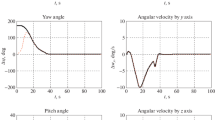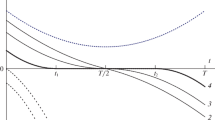Abstract
This paper presents an algorithm for the terminal synthesis of the orbital orientation for a spacecraft. The algorithm is based on solving the following problems: the analytical determination of the program values for the angular velocity vector components in an orbital coordinate system and the stabilization of the program values for the turn rate vector components and the desired terminal angular position of a spacecraft. The program values of the angular velocity vector components are determined analytically using the method previously proposed by the authors for solving a boundary value problem based on the parameter identification of a discrete model with the use of modal control. The simulation results demonstrating the effectiveness of the proposed algorithm, as well as the high accuracy level of the steady-state control, are presented.
Similar content being viewed by others
References
N. E. Zubov, “Algorithmic support of automatic mode of spacecraft orbital orientation,” Izv. Akad. Nauk SSSR, Tekh. Kibernet., No. 2, 193–202 (1990).
N. E. Zubov, “Optimal control of spacecraft terminal reorientation based on algorithm with forecasting model,” Kosm. Issled. 29, 340–350 (1991).
Reference Book on Automatic Control, Ed. by A. A. Krasovskii (Nauka, Moscow, 1987) [in Russian].
E. A. Mikrin, N. E. Zubov, S. S. Negodyaev, et al., “Optimal control of spacecraft orbital orientation based on algorithm with forecasting model,” Tr. MFTI 2, 189–195 (2010).
N. E. Zubov, E. A. Mikrin, M. Sh. Misrikhanov, V. N. Ryabchenko, S. N. Timakov, and E. A. Cheremnykh, “Identification of the position of an equilibrium attitude of the international space station as a problem of stable matrix completion,” J. Comput. Syst. Sci. Int. 51, 291 (2012).
N. E. Zubov, E. A. Mikrin, M. Sh. Misrikhanov, A. S. Oleinik, and V. N. Ryabchenko, “Terminal bang-bang impulsive control of linear time invariant dynamic systems,” J. Comput. Syst. Sci. Int. 53, 430 (2014).
N. E. Zubov, E. A. Mikrin, M. Sh. Misrikhanov, V. N. Ryabchenko, and S. N. Timakov, “The use of the exact pole placement algorithm for the control of spacecraft motion,” J. Comput. Syst. Sci. Int. 52, 129 (2013).
N. E. Zubov, E. A. Mikrin, V. N. Ryabchenko, and S. N. Timakov, “The use of an adaptive bandpass filter as an observer in the control loop of the international space station,” J. Comput. Syst. Sci. Int. 51, 560 (2012).
E. A. Vorob’eva, N. E. Zubov, E. A. Mikrin, M. Sh. Misrikhanov, V. N. Ryabchenko, and S. N. Timakov, “Synthesis of stabilizing spacecraft control based on generalized Ackermann’s formula,” J. Comput. Syst. Sci. Int. 50, 93 (2011).
A. V. Bogachev, E. A. Vorob’eva, N. E. Zubov, E. A. Mikrin, M. Sh. Misrikhanov, V. N. Ryabchenko, and S. N. Timakov, “Unloading angular momentum for inertial actuators of a spacecraft in the pitch channel,” J. Comput. Syst. Sci. Int. 50, 483 (2011).
N. E. Zubov, E. A. Mikrin, M. Sh. Misrikhanov, and V. N. Ryabchenko, “Synthesis of decoupling laws for attitude stabilization of a spacecraft,” J. Comput. Syst. Sci. Int. 51, 80 (2012).
N. E. Zubov, E. A. Mikrin, M. Sh. Misrikhanov, and V. N. Ryabchenko, “Modification of the exact pole placement method and its application for the control of spacecraft motion,” J. Comput. Syst. Sci. Int. 52, 279 (2013).
N. E. Zubov, E. A. Mikrin, M. Sh. Misrikhanov, and V. N. Ryabchenko, “Synthesis of controls for a spacecraft that optimize the pole placement of the closed-loop control system,” J. Comput. Syst. Sci. Int. 51, 431 (2012).
N. E. Zubov, E. A. Mikrin, V. N. Ryabchenko, A. S. Oleinik, and D. E. Efanov, “The spacecraft angular velocity estimation in the orbital stabilization mode by the results of the local vertical sensor measurement,” Vest. MGTU Im. N.E. Baumana, Ser. Priborostroen., No. 5, 3–17 (2014).
V. A. Besekerskii and E. P. Popov, Theory of Automatic Regulation Systems (Nauka, Moscow, 1975) [in Russian].
Yu. F. Golubev, “Quaternion algebra in rigid body kinematics,” KIAM Preprint No. 39 (Keldysh Inst. Appl. Math., Moscow, 2013). http://library.keldysh.ru/preprint.asp?id=2013-39
N. E. Zubov, A. V. Lapin, and E. A. Mikrin, “Application of the exact pole placement method to the problem of space vehicle attitude reduction in terms of quaternion elements,” Vest. Komp. Inform. Tekhnol., No. 3, 3–9 (2014).
Author information
Authors and Affiliations
Corresponding author
Additional information
Original Russian Text © N.E. Zubov, M.V. Li, E.A. Mikrin, V.N. Ryabchenko, 2017, published in Izvestiya Akademii Nauk, Teoriya i Sistemy Upravleniya, 2017, No. 4, pp. 154–173.
Rights and permissions
About this article
Cite this article
Zubov, N.E., Li, M.V., Mikrin, E.A. et al. Terminal synthesis of orbital orientation for a spacecraft. J. Comput. Syst. Sci. Int. 56, 721–737 (2017). https://doi.org/10.1134/S1064230717040190
Received:
Accepted:
Published:
Issue Date:
DOI: https://doi.org/10.1134/S1064230717040190




